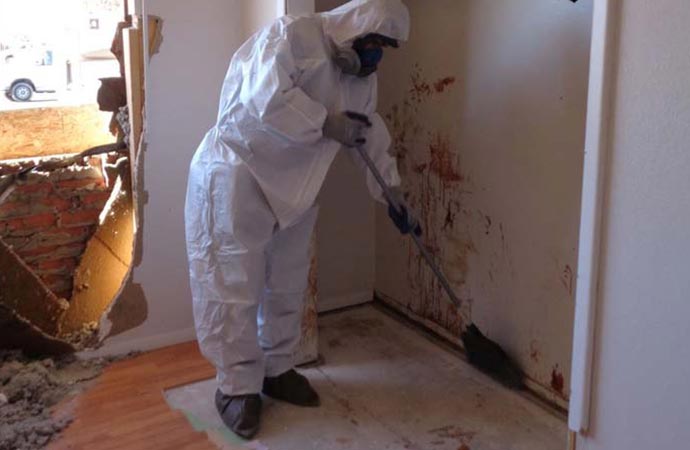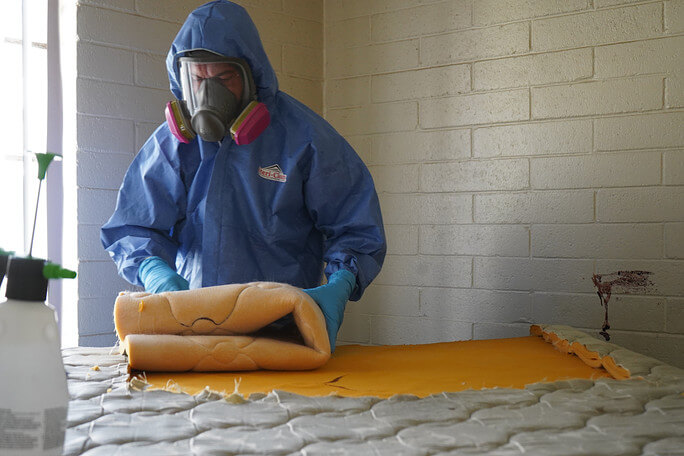Biohazard Removal: Safe Handling and Disposal of Hazardous Products
Biohazard Removal: Safe Handling and Disposal of Hazardous Products
Blog Article
Expert Biohazard Cleansing and Decontamination for Blood, Bodily Fluids, and Hazardous Materials
In the world of biohazard cleansing and decontamination for blood, bodily liquids, and harmful products, accuracy and experience are vital. The possible health threats linked with exposure to biohazards underscore the important requirement for meticulous handling and thorough clean-up. Specialized training equips experts with the expertise and skills essential to resolve these hazardous scenarios effectively. Nonetheless, it is not just regarding cleansing up; the relevance of using correct decontamination techniques can not be overstated. As we navigate the complex landscape of biohazard cleaning, recognizing the subtleties of policies, compliance, and the specific equipment at play comes to be critical in making sure a risk-free and extensive decontamination process.
Health Dangers of Biohazard Exposure
Exposure to biohazards positions considerable health risks that can lead to serious effects for individuals and areas alike. Biohazards encompass a wide variety of organic materials, including blood, physical fluids, mold, germs, infections, and other possibly infectious products. When individuals enter into contact with these biohazards, whether with mishaps, improper handling, or environmental exposure, they face the risk of contracting severe diseases or illness.
Among the primary wellness risks related to biohazard direct exposure is the transmission of transmittable diseases. Bloodborne virus such as HIV, liver disease B and C, and different germs can be present in biohazardous materials, positioning a straight hazard to human health and wellness. Inhaling air-borne biohazards like mold spores or coming right into call with infected surface areas can also bring about respiratory issues, allergic reactions, and various other damaging health and wellness effects.
Moreover, biohazard direct exposure can have lasting health implications, with some diseases materializing years after the first get in touch with (Blood Cleanup). Consequently, it is critical to prioritize proper biohazard cleaning and purification to mitigate these health dangers and guarantee the security of neighborhoods and individuals

Specialized Training for Biohazard Clean-up
When it pertains to managing biohazard clean-up efficiently and securely, specialized training plays a basic role in making certain proper decontamination treatments are adhered to. Biohazard cleanup calls for certain expertise and skills to successfully alleviate threats connected with bloodborne pathogens, physical fluids, and dangerous products. Specialists learnt biohazard cleanup undertake extensive instruction on just how to safely deal with, eliminate, and take care of biohazardous materials to avoid contamination and exposure.
Specialized training for biohazard cleanup covers a variety of essential topics, consisting of proper personal safety equipment (PPE) usage, bloodborne microorganism understanding, decontamination techniques, and unsafe waste disposal protocols. Individuals learnt biohazard cleanup are furnished with the essential know-how to analyze contamination levels, identify prospective dangers, and implement proper cleaning procedures in conformity with regulative criteria.
Continual training and education are vital in the field of biohazard cleanup to stay upgraded on the latest decontamination modern technologies, security procedures, and guidelines. By buying specialized training, biohazard cleanup experts can properly respond to emergency clean-up circumstances and safeguard both public health and the environment.
Importance of Correct Purification Methods
Making use of proper purification techniques is critical in biohazard cleanup to properly decrease and eliminate hazardous materials health threats. Reliable purification not just makes certain the removal of visible traces of blood, bodily fluids, and other biohazards yet likewise targets unnoticeable microorganisms that may pose major health dangers if not properly eliminated. By complying with rigorous decontamination procedures, trained professionals can substantially reduce the risk of exposure to unsafe bacteria, infections, and bacteria that can lead to illness or infections.
Appropriate purification strategies include making use of customized equipment and disinfectants that are specifically designed to neutralize biohazards efficiently. Complete cleansing and sanitation of infected areas are necessary to protect against the spread of virus and make certain a secure atmosphere for occupants. In addition, the appropriate disposal of biohazardous waste adhering to purification procedures is crucial in stopping contamination of other surface areas or people.

Tools and Devices for Safe Clean-up
When dealing with blood, physical fluids, or dangerous products, biohazard cleansing specialists rely on specialized gear to lessen direct exposure dangers and extensively decontaminate the damaged area. Furthermore, biohazard cleansing kits having disinfectants, absorbing materials, and click here to find out more biohazard bags are made use of to securely consist of and get rid of of infected items.
Advanced cleansing tools like hospital-grade anti-bacterials, HEPA-filtered vacuums, and misting devices are employed to sterilize surfaces and remove biohazards effectively. Specialized devices such as sharps containers and biohazard waste disposal containers are utilized to securely handle sharp objects and biohazardous waste materials. By utilizing the right devices and tools, biohazard cleansing specialists can make certain a complete clean-up procedure that prioritizes safety and security and decreases health risks for both workers and residents of the affected room.
Rules and Compliance in Biohazard Cleaning
Correct adherence to policies and compliance check out this site standards is paramount in biohazard cleaning to guarantee the safety of both workers and the environment. Federal government companies such as OSHA (Occupational Security and Health And Wellness Management) and the EPA (Environmental Defense Company) have developed specific guidelines for biohazard clean-up treatments to lessen wellness dangers and environmental contamination. These laws cover a range of aspects including the handling, transport, and disposal of biohazardous materials, in addition to the needed training and protective tools needed for workers involved in the clean-up procedure.
Biohazard cleansing companies must stay current with these laws to assure that their procedures fulfill the needed safety and security requirements. Failing to abide with these regulations can lead to extreme consequences, consisting of fines, legal activity, and jeopardizing the health and wellness of individuals and the setting. By following strict policies and compliance procedures, biohazard cleaning business can properly reduce dangers and make certain a complete and secure cleanup process for all celebrations included.
Final Thought
In verdict, biohazard cleansing and decontamination require customized training, correct methods, and adherence to laws. Direct exposure to blood, bodily fluids, and hazardous materials presents substantial health and wellness risks, making it essential to use the ideal equipment and tools for safe clean-up. By following rigorous methods and guidelines, professionals can efficiently mitigate the dangers connected with biohazard exposure and ensure the safety of both themselves and others.
As we browse the intricate landscape of useful link biohazard clean-up, recognizing the nuances of policies, conformity, and the specialized tools at play comes to be necessary in making sure a extensive and risk-free purification process. (Blood Cleanup)
When it comes to dealing with biohazard cleanup successfully and safely, specialized training plays an essential role in guaranteeing proper purification procedures are complied with.Using appropriate decontamination strategies is essential in biohazard cleanup to successfully lessen and eliminate harmful products health threats. In addition, biohazard cleansing kits including disinfectants, absorbent materials, and biohazard bags are utilized to safely contain and get rid of of polluted things.
Government firms such as OSHA (Occupational Security and Health And Wellness Management) and the EPA (Environmental Defense Firm) have established specific guidelines for biohazard clean-up treatments to minimize health and wellness risks and ecological contamination.
Report this page